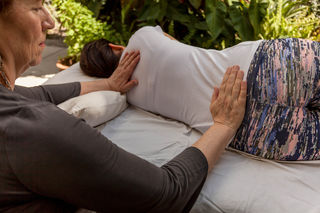Sleep
The One Exercise That I Teach to All of My Clients
A forgotten method can help others deeply relax.
Posted May 3, 2018
Therapeutic Rocking
When I have a couple, or parents or even friends where one or both individuals experience anxiety, stress, insomnia, pain or PTSD, I teach them how to do therapeutic rocking. Both the person receiving and the person giving, benefit, and I suggest that people alternate with one person rocking the other every other day. Below I describe how to do therapeutic rocking and how to teach it.
I began my career rocking children with autism who were brought to my clinic in Mexico for a combination of nature adventure therapy and bodywork. Distressed children often rock themselves in an effort to self-sooth. I followed up this work during my first clinical internship on a psychogeriatric ward at the Lemuel Shattuck Hospital, a public health hospital in Boston. The staff was interested in whether we could avoid giving the afternoon dose of benzodiazepines to the aging, bed-ridden women who were diagnosed with paranoid schizophrenia. I offered to rock them, while they lay on their sides, to see if we could help them decrease their agitation and to relax. Most went to sleep. Later during my clinical fellowship at a Harvard teaching hospital, I rocked patients who were suicidal and called "borderline" (they were really trauma survivors); the nurses understood the benefits, the psychiatrists had a harder time in those days of " therapeutic withholding" (not holding).
(Note: I am dually certified and licensed in bodywork and psychotherapy and I don't recommend that mental health clinicians do the rocking but instead teach the technique to their clients.)
Despite its efficacy, rocking an individual is more labor intensive than a pill and it may be that what we have come to accept as efficacious is really just more efficient. Nevertheless, rocking is something I teach couples, partners, or friends as well as bodyworkers. One can help veterans who cannot calm down in the evening, or rape survivors who cannot sleep, and children and adults of all ages can reduce symptoms of anxiety, panic, and pain, and improve sleep.
Benefits of Rocking
Rocking is a universal behavior; it synchronizes the brain and accelerates and improves the quality of sleep (Bayer et al., 2011). Rocking increases sleep spindles, which are associated with being able to sleep through environmental noise (Bayer et al., 2011). Rocking at all stages of life engages the template of touch and the inner infant. We don’t grow out of the need for this kind of soothing; we just don’t generally receive it or give it as adults.
The benefits of rocking derive from the same principle of why we rock babies to sleep; we pat the sacrum at the bottom of the spine in a soothing rhythmic way with one hand as we hold and cradle the brachial plexus at the lower neck (or holding the head) with the other. The baby may be placed on her stomach or in a hammock to sleep, or held by an adult relaxing in a rocking chair.

Exercise: Body Rocking
When I have a couple, or parents or even friends with one or both individuals experiencing anxiety, stress, insomnia, pain or PTSD I teach them how to rock. To begin, have the person receiving the treatment lie on their right side (if they are comfortable this way). The right side activates the rest cycle of the right brain hemisphere and will induce sleep more quickly. Place a pillow under their neck. Some people also feel comfortable hugging a pillow at their belly. The person giving the treatment will sit behind them. Then the “giver” will take their left palm, fingers placed upward (toward the sky), and place it directly over the sacrum. The left palm should be covering the sacrum, so that the outer edge of the little finger is just above the intergluteal cleft before the buttocks (the hand will not be in contact with the buttocks), and the thumb is around the sacro-iliac line. The right hand can be placed right on the neck on the cervical vertebrae, and the hand will cup very naturally around the neck. The quality of touch is very light with no pressure. Very gently begin rocking the sacrum by pushing with the left palm. You don’t need to get a lot of movement for this to work and your movement should be adjusted for the comfort of your partner. Do this for a minimum of 10 minutes, with gentle suggestion for breathing, closed eyes and up to 20 minutes until your partner falls asleep or is sufficiently relaxed.
References
Rocking synchronizes brain waves during a short nap. Bayer, Laurence et al. Current Biology , Volume 21 , Issue 12 , R461 - R462


